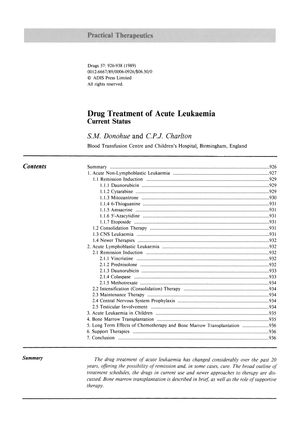Drug Treatment of Acute Leukaemia Current Status
June 1989
in “
Drugs
”

TLDR Treatments for acute leukaemia lead to high remission rates, but relapses occur, requiring ongoing advancements in care.
The document from 1989 reviews the treatment strategies for acute leukaemia, including acute lymphoblastic leukaemia (ALL) and acute non-lymphoblastic leukaemia (ANLL). It reports that approximately 80% of cases achieve remission, but relapse is common, leading to the use of consolidation treatment and bone marrow transplantation (BMT) to improve long-term survival. Various chemotherapeutic agents and their side effects are discussed, with a focus on drugs like amsacrine, 5'-azacytidine, and etoposide, noting their response rates and toxicities such as alopecia and gastrointestinal issues. The document also covers the management of leukaemia in children, with ALL being the most common childhood malignancy, leading to 93% complete remissions and up to 60% long-term survival in a subgroup of girls. Long-term effects of treatment, including learning difficulties and second malignancies, are mentioned, as well as the importance of supportive therapies. The success of BMT is linked to the patient's condition and remission status, with side effects like sterility and psychological trauma. The conclusion highlights the progress in treating acute leukaemia but recognizes the need for further advancements.